Menus
- First contact with the new Kawa
- Video of the driving presentation of the Kawasaki Z 900
- The increase in displacement is noticeable in the performance data
- First get-to-know date around Almeria
- First compulsory exercise: city traffic
- 21 kilograms less have a positive effect
- Kawasaki Z 900 comes without traction control
- Purchase price remained the same
- Technical data Kawasaki Z 900
- Kawasaki Z 900 sales in Germany
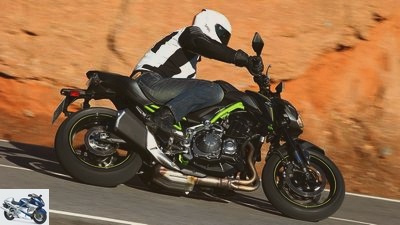
Kawasaki
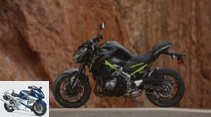
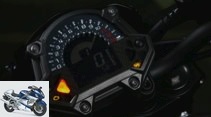
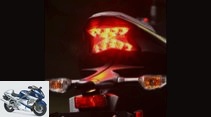
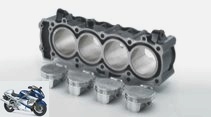
17th photos
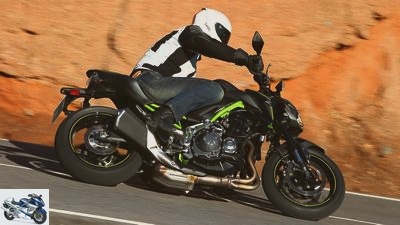
Kawasaki
1/17
Kawasaki Z 900
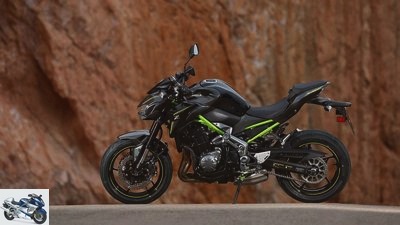
Kawasaki
2/17
Dipped in bright green, the new tubular steel lattice frame accommodates the engine as a load-bearing element
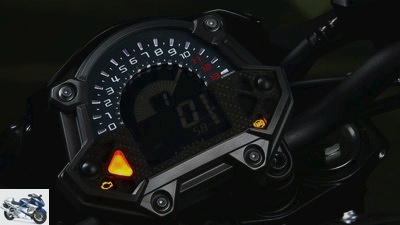
Kawasaki
3/17
Small cockpit with lots of information including gear indicator. The tachometer needle feels good everywhere – above and below
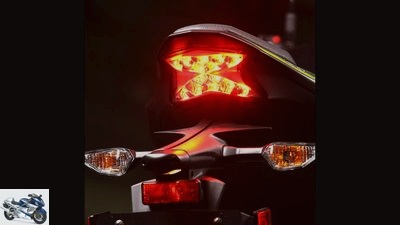
Kawasaki
4/17
For drivers behind: the rear light of the 900 as a design element in a jagged, slim Z-shape

Kawasaki
5/17
A look inside the engine. Basically it comes from the Z 1000. As with its big sister, the Z 900 has a stroke of 56 millimeters, only the bore is smaller at 73.4 millimeters
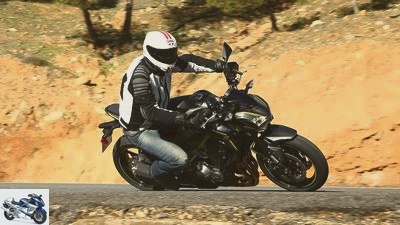
Kawasaki
6/17
Kawasaki Z 900.
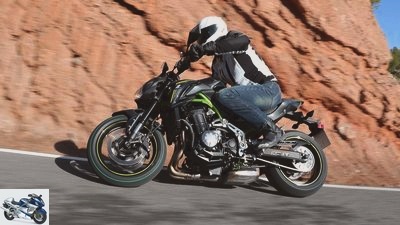
Kawasaki
7/17
Kawasaki Z 900.
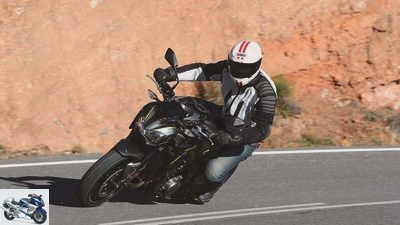
Kawasaki
8/17
Kawasaki Z 900.
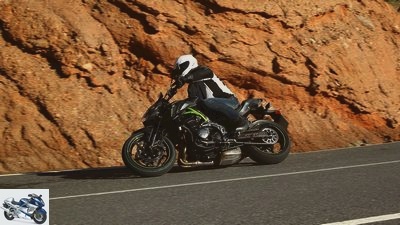
Kawasaki
9/17
Kawasaki Z 900.

Kawasaki
10/17
Kawasaki Z 900.
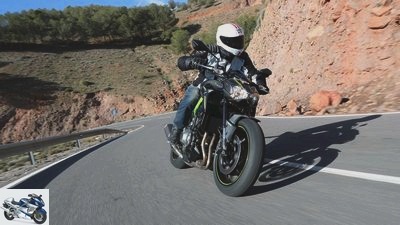
Kawasaki
11/17
Kawasaki Z 900.
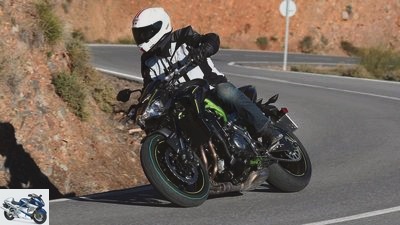
Kawasaki
12/17
Kawasaki Z 900.
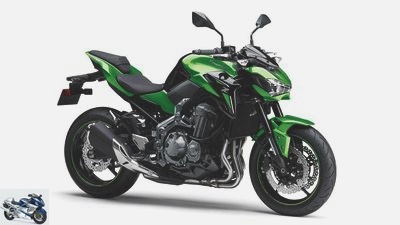
Kawasaki
13/17
Kawasaki Z 900.
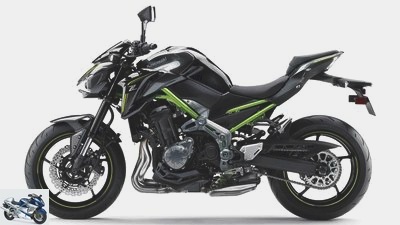
Kawasaki
14/17
Kawasaki Z 900.
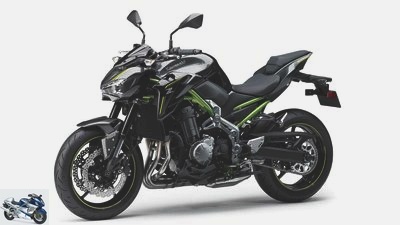
Kawasaki
15/17
Kawasaki Z 900.
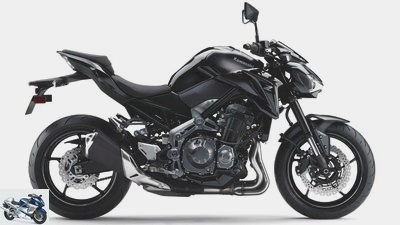
Kawasaki
16/17
Kawasaki Z 900.
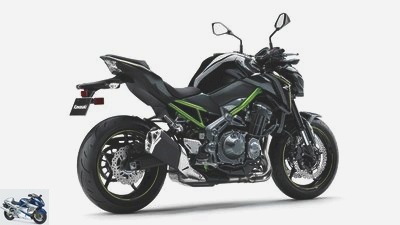
Kawasaki
17/17
Kawasaki Z 900.
Kawasaki Z 900 in the driving report
First contact with the new Kawa
The old Kawasaki Z 800 now ekes out its existence as a retiree, the new Kawasaki Z 900 takes over. More jaggedness through more power and less weight make you sit up and take notice. The summary after the first contact.
Just a reminder: In 2004 the first Z 750 appeared, the modern ancestor of the current Z 900. Its four pistons were allowed to use exactly 748 cm³ displacement for up and down. The parallel available Z 1000, at that time still with the wonderfully slim exhaust system, had a displacement of 953 cubic centimeters. Why is it important? Because the new Kawasaki Z 900 as an in-line four now comes to 948 cm³ and is therefore damn close to the old Z 1000. Kawasaki is upgrading the upper middle class in terms of displacement. And it’s not far to the 1043 cm³ from which the current Z 1000 mobilizes its power.
Buy complete article

Kawasaki Z 900 in the driving report
First contact with the new Kawa
“If we do it, we’ll do it right”
This is particularly important because with the Kawasaki Z 900, Kawasaki is not sending a slightly finely honed Z 800 into the race for the customer’s favor, but has completely turned the model inside out. That deserves respect, especially because the Z 800, as it was in the store until 2016, generated decent sales. 1,886 Z-Angefixte grabbed it last year, succumbing to the aggressive Sugomi design. That was enough for Kawasaki internally for second place on the approval hit list. In order to master the Euro 4 requirements, slight adjustments would certainly have been sufficient. But they didn’t want that in Akashi. “If we do it, we’ll do it right,” seemed the motto.
Video of the driving presentation of the Kawasaki Z 900
The increase in displacement is noticeable in the performance data
The old 800 engine was passed on completely to the scrap metal. Instead, the focus was on the Z 1000 engine, pulling out his organ donation card. In detail, this means: At 56 millimeters, the stroke of the Kawasaki Z 900 remains the same as that of the 1000, but the bore shrank from 77 to 73.4 millimeters. For this purpose, smaller throttle valves are installed that send the gasoline-air mixture through openings measuring 36 millimeters towards the engine – on the Z 1000 they are two millimeters larger. The whole thing is exhaust-gas cleaned in accordance with the Euro 4 norm, and the new Z 900 unit is ready. The increase in displacement compared to the 800 is directly noticeable in the performance data. Kawasaki promises 125 hp at 9500 rpm and a good 99 Nm just under 2,000 rpm for the middle class naked. A big surcharge compared to the Z 800, which was listed with 113 hp and 83 Nm. It all sounds very tempting.
First get-to-know date around Almeria
Also because not only did the four-cylinder basically come on the dissecting table, but also because nothing in the chassis is what it was before. Where the old Z 800 engine had to hide shyly behind numerous plastic panels due to the unsightly steel bridge frame, the strengthened power source is easy to see thanks to the new tubular space frame. The mesh of individual tubes sharpens the look and, as a positive side effect, lets the pounds tumble in droves. The frame should only weigh 13.5 kilograms, the lightweight aluminum swing arm also weighs in at a spartan 3,900 grams. Together with other changes, the total weight should scratch the 210 kilogram mark. As a reminder: on the Z 800, the pointer only stopped at a remeasured 231 double pounds. The less in mass is therefore neat. Around Almería, Kawasaki asked for a first meeting. Let’s see if the new Kawasaki Z 900 can implement the promises of its key data in reality?
First compulsory exercise: city traffic
The corridors race cleanly in the hustle and bustle through cars and roundabouts from bottom to top and back. The new assist clutch with anti-hopping function combines easy operation with good dosage. Even in gear five, the Kawasaki Z 900 whispered past the canyons. The gear stages from one to five are short, while Kawasaki wants to see stage six as overdrive. Although the engine goes along with the rumbling without complaint, slight changes in load are noticeable when the throttle position is constantly corrected.
21 kilograms less have a positive effect
From now on they no longer appear: the landscape opens up, a wildly meandering curve band of wide arches and tight bends is on the program. The Kawasaki Z 900 sweeps lightly through the various radii. A credible 21 kilograms less have a positive effect. In addition, the wide handlebars, which lie comfortably in the hand, are only slightly cranked and offer an effective lever arm to initiate steering impulses. In the jumble of curves, the four-in-line no longer attracts attention with load changes, but rather inspires with powerful power delivery through the entire speed range. He even masters hairpin bends in fourth gear without using the clutch – if you want to. Then the four-wheeler needs a few revolutions to accelerate out of the way until it delivers brilliant propulsion again, but the fact that this is possible at all shows the well-mannered manners and the good engine tuning. Jointly responsible for this: the intake funnels of different lengths. The outer cylinders breathe through 50 millimeter long throats – good for a decent performance out at the top, the inner cylinders inhale the air through specimens 150 millimeters long. This boosts the torque even at low speeds.
Kawasaki Z 900 comes without traction control
The guide has had enough of the sightseeing mode, picking up the pace. The engine doesn’t care. Simply drive everything down a gear, because the Four fires with vehemence up to the rev limiter if necessary. He doesn’t know any holes or breaks. And since it underlines the cheers with a pithy, beautiful suction noise, every revving from the apex becomes a feast for the ear. Mind you, only for the driver, not for the environment. That turns on, stimulates. But be careful: The Kawasaki Z 900 comes without traction control. The mounted Dunlop D 214 in special specification Z grip very well once they have been brought up to temperature, but they are not good for miracles with spontaneously appearing dirt on the road. The TC is a security feature that is missing.
Purchase price remained the same
But the Z 900 does everything right again elsewhere. The four-piston calipers at the front bite smoothly into the two 300-millimeter-measuring discs in wave design, the ABS regulates brake peaks safely and without any pitfalls. Even when decelerating hard, the fork remains steadfast, preventing too deep immersion with rich damping. Whereby Kawasaki the chassis is overall well done. Moved slowly or briskly, the Z 900 is always very full on the road, unrest is alien to it. Even on bumpy slopes, it does not lose its composure, remains stable on course and also offers everyday comfort. If it does, it suffers a little because of the seating position. The pegs are raised to facilitate the lean angle, and low in the motorcycle, only 795 millimeters above the ground. That pinches your knees. However, Kawasaki will offer a higher seat, which not only makes life easier for long, but also makes sporty curve scrapers happy. Can you put even more pressure on the front wheel when braking? The driving day is history, what is stuck? The Kawasaki Z 900 was really good at the jaggedness cure, almost forgetting the predecessor Z 800. Mainly because the purchase price has remained the same: 8,895 euros. There is only one thing to worry about: Quo vadis, Z 1000?
Technical data Kawasaki Z 900
Technical data Kawasaki Z 900
Engine: Water-cooled four-cylinder, four-stroke in-line engine, a balance shaft, two overhead, chain-driven camshafts, four valves per cylinder, bucket tappets, wet sump lubrication, injection, 4 x Ø 36 mm, regulated catalytic converter, 520 W alternator, 12 V / 8 Ah battery, mechanically operated multiple discs -Oil bath clutch (anti-hopping), six-speed gearbox, O-ring chain, secondary ratio 44:15.
Bore x stroke: 73.4 x 56.0 mm
Displacement: 948 cc
Compression ratio: 11.8: 1
Rated capacity: 92.2 kW (125 hp) at 9,500 rpm
Max. Torque: 99 Nm at 7,700 rpm
Landing gear: Steel tubular frame, upside-down fork, Ø 41 mm, adjustable spring base and rebound damping, two-arm swing arm made of aluminum, central spring strut, lying, with lever system, adjustable spring base and rebound damping, double disc brake at the front, Ø 300 mm, four-piston fixed calipers, disc brake at the rear, Ø 250 mm, single-piston floating caliper, ABS.
Cast aluminum wheels: 3.50 x 17; 5.50 x 17
Tires: 120/70 ZR 17; 180/55 ZR 17
Dimensions + weights: Wheelbase 1450 mm, steering head angle 65.0 degrees, caster 105 mm, spring travel f / r 120/140 mm, seat height 795 mm, weight with a full tank of 210 kg, permissible total weight 390 kg, tank capacity 17.0 liters.
Guarantee: two years
Colours: Gray, green, black
Price: 8,895 euros
Additional costs: 255 euros
Kawasaki Z 900 sales in Germany
1000PS marketplace app
The Z900 impresses with its performance and good availability.
With the Z 900, Kawasaki has shot itself straight into the hearts of naked bike fans, which is why the stock on the used market is very extensive. Many copies have already been equipped with the most important accessories in order to add the right optics to the performance of the Z 900. Here is the price comparison: used Kawasaki Z900 in Germany.
Related articles
-
Suzuki GSX-R 1000 R in the driving report
Suzuki 27 photos Suzuki 1/27 Suzuki GSX-R 1000 R. Suzuki 2/27 Suzuki GSX-R 1000 R. Suzuki 3/27 Suzuki GSX-R 1000 R Suzuki 4/27 Suzuki GSX-R 1000 R….
-
Photo: Kawasaki 24 photos Kawasaki 1/24 Kawasaki 2/24 Kawasaki 3/24 Kawasaki 4/24 Kawasaki 5/24 Kawasaki 6/24 Kawasaki 7/24 Kawasaki 8/24 Kawasaki 9/24…
-
Driving report Yamaha TT 600 R
Driving report Yamaha TT 600 R One still works In its twentieth year of service, Yamaha’s field horse TT 600 is once again subjected to a fitness regimen…
-
Triumph Rocket III in the driving report: more and less
triumph 9 photos triumph 1/9 Even more displacement and Newton meters, but at the same time the weight screwed down. Does not sound bad. triumph 2/9…
-
Kawasaki Z 650 in the driving report
Kawasaki 9 photos Kawasaki 1/9 Photo gallery: Kawasaki Z 650 in the driving report. Kawasaki 2/9 The diet worked: Compared to the ER-6n, the Z 650 has…
-
Driving report Bimota SB 6 R Draft horse Often promised – never kept. Only the SB 6 R has what the SB 6 was previously lacking: power and performance. The thing …
-
First driving report of the Kawasaki GPZ 900 R (MOTORRAD 1-1984)
Archive 26 pictures Archive 1/26 Light, strong and fast was the formula for the Kawasaki superbike of the 1980s, the GP Z 900 R. Archive 2/26 According to …
-
Ducati Panigale R in the driving report
Ducati 20 pictures Ducati 1/20 Technically, in terms of weight and price, the Panigale R lies between the Superleggera and the 1299 Panigale S. Ducati 2/20 …
-
Kawasaki Versys 1000 driving report
Wright Driving report: Kawasaki Versys 1000 (with video) Kawasaki’s all-rounder now with a large four-cylinder No half measures: For the Versys there is…
-
Honda RC213V-S in the driving report
Honda 19th photos Honda 1/19 The number of units of the Honda RC213V-S is small, but the price is high. You have to bring 200,000 euros. In return you…